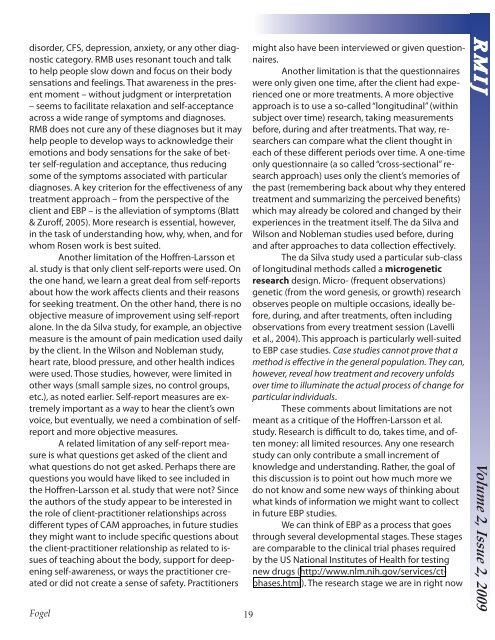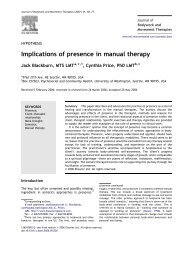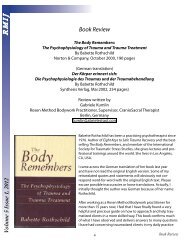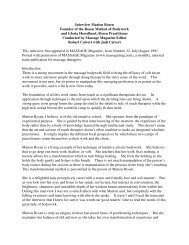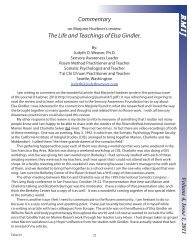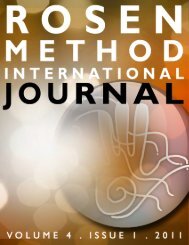RMIJ ... - Rosen Journal
RMIJ ... - Rosen Journal
RMIJ ... - Rosen Journal
You also want an ePaper? Increase the reach of your titles
YUMPU automatically turns print PDFs into web optimized ePapers that Google loves.
disorder, CFS, depression, anxiety, or any other diagnostic<br />
category. RMB uses resonant touch and talk<br />
to help people slow down and focus on their body<br />
sensations and feelings. That awareness in the present<br />
moment – without judgment or interpretation<br />
– seems to facilitate relaxation and self-acceptance<br />
across a wide range of symptoms and diagnoses.<br />
RMB does not cure any of these diagnoses but it may<br />
help people to develop ways to acknowledge their<br />
emotions and body sensations for the sake of better<br />
self-regulation and acceptance, thus reducing<br />
some of the symptoms associated with particular<br />
diagnoses. A key criterion for the effectiveness of any<br />
treatment approach – from the perspective of the<br />
client and EBP – is the alleviation of symptoms (Blatt<br />
& Zuroff, 2005). More research is essential, however,<br />
in the task of understanding how, why, when, and for<br />
whom <strong>Rosen</strong> work is best suited.<br />
Another limitation of the Hoffren-Larsson et<br />
al. study is that only client self-reports were used. On<br />
the one hand, we learn a great deal from self-reports<br />
about how the work affects clients and their reasons<br />
for seeking treatment. On the other hand, there is no<br />
objective measure of improvement using self-report<br />
alone. In the da Silva study, for example, an objective<br />
measure is the amount of pain medication used daily<br />
by the client. In the Wilson and Nobleman study,<br />
heart rate, blood pressure, and other health indices<br />
were used. Those studies, however, were limited in<br />
other ways (small sample sizes, no control groups,<br />
etc.), as noted earlier. Self-report measures are extremely<br />
important as a way to hear the client’s own<br />
voice, but eventually, we need a combination of selfreport<br />
and more objective measures.<br />
A related limitation of any self-report measure<br />
is what questions get asked of the client and<br />
what questions do not get asked. Perhaps there are<br />
questions you would have liked to see included in<br />
the Hoffren-Larsson et al. study that were not? Since<br />
the authors of the study appear to be interested in<br />
the role of client-practitioner relationships across<br />
different types of CAM approaches, in future studies<br />
they might want to include specific questions about<br />
the client-practitioner relationship as related to issues<br />
of teaching about the body, support for deepening<br />
self-awareness, or ways the practitioner created<br />
or did not create a sense of safety. Practitioners<br />
Fogel<br />
19<br />
might also have been interviewed or given questionnaires.<br />
Another limitation is that the questionnaires<br />
were only given one time, after the client had experienced<br />
one or more treatments. A more objective<br />
approach is to use a so-called “longitudinal” (within<br />
subject over time) research, taking measurements<br />
before, during and after treatments. That way, researchers<br />
can compare what the client thought in<br />
each of these different periods over time. A one-time<br />
only questionnaire (a so called “cross-sectional” research<br />
approach) uses only the client’s memories of<br />
the past (remembering back about why they entered<br />
treatment and summarizing the perceived benefits)<br />
which may already be colored and changed by their<br />
experiences in the treatment itself. The da Silva and<br />
Wilson and Nobleman studies used before, during<br />
and after approaches to data collection effectively.<br />
The da Silva study used a particular sub-class<br />
of longitudinal methods called a microgenetic<br />
research design. Micro- (frequent observations)<br />
genetic (from the word genesis, or growth) research<br />
observes people on multiple occasions, ideally before,<br />
during, and after treatments, often including<br />
observations from every treatment session (Lavelli<br />
et al., 2004). This approach is particularly well-suited<br />
to EBP case studies. Case studies cannot prove that a<br />
method is effective in the general population. They can,<br />
however, reveal how treatment and recovery unfolds<br />
over time to illuminate the actual process of change for<br />
particular individuals.<br />
These comments about limitations are not<br />
meant as a critique of the Hoffren-Larsson et al.<br />
study. Research is difficult to do, takes time, and often<br />
money: all limited resources. Any one research<br />
study can only contribute a small increment of<br />
knowledge and understanding. Rather, the goal of<br />
this discussion is to point out how much more we<br />
do not know and some new ways of thinking about<br />
what kinds of information we might want to collect<br />
in future EBP studies.<br />
We can think of EBP as a process that goes<br />
through several developmental stages. These stages<br />
are comparable to the clinical trial phases required<br />
by the US National Institutes of Health for testing<br />
new drugs (http://www.nlm.nih.gov/services/ctphases.html).<br />
The research stage we are in right now<br />
<strong>RMIJ</strong> Volume 2, Issue 2, 2009


